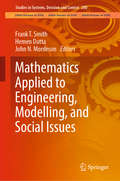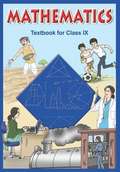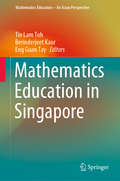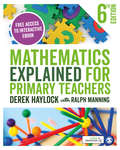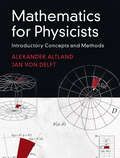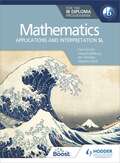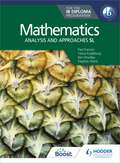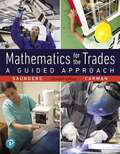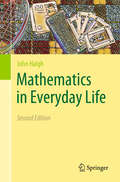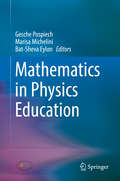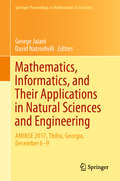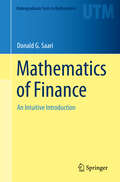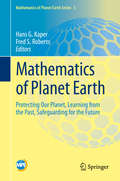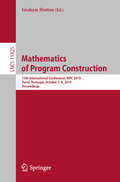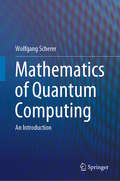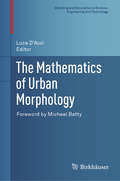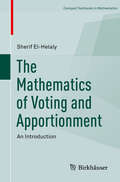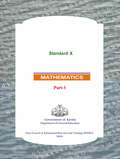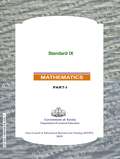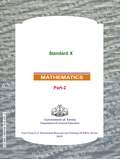- Table View
- List View
Mathematics Applied to Engineering, Modelling, and Social Issues (Studies in Systems, Decision and Control #200)
by John N. Mordeson Hemen Dutta Frank T. SmithThis book presents several aspects of research on mathematics that have significant applications in engineering, modelling and social matters, discussing a number of current and future social issues and problems in which mathematical tools can be beneficial. Each chapter enhances our understanding of the research problems in a particular an area of study and highlights the latest advances made in that area. The self-contained contributions make the results and problems discussed accessible to readers, and provides references to enable those interested to follow subsequent studies in still developing fields. Presenting real-world applications, the book is a valuable resource for graduate students, researchers and educators. It appeals to general readers curious about the practical applications of mathematics in diverse scientific areas and social problems.
Mathematics class 10 - Meghalaya Board
by Meghalaya Board of School EducationCreated and published by the Meghalaya School Board of School Education, the textbook for class 10 helps the students to understand various basics for higher level maths and prepare them for the examinations. Written in simple english language the book is full of solved examples for the students to understand the concept better.
Mathematics class 9 - NCERT
by National Council of Educational Research and TrainingMathematics Textbook For Class IX has been designed in a way so as to enable students to tackle difficult mathematical problems with ease. Published by NCERT, this book comprehensively covers the curriculum for the CBSE board and provides convenient ways of solutions to various numerical problems. The textbook has copious diagrams and solved examples to facilitate easier understanding and better adaptability among students. Unnecessary jargon is kept at bay, making mathematics more interesting for the students. Every topic is supported with abundant solved examples and practice sums to constitute a complete learning experience.
Mathematics class 9 - Tamil Nadu Board
by Government Of TamilnaduMathematics Textbook For Class IX has been designed in a way so as to enable students to tackle difficult mathematical problems with ease. Published by SCERT, this book comprehensively covers the curriculum for the board and provides convenient ways of solutions to various numerical problems. The textbook has copious diagrams and solved examples to facilitate easier understanding and better adaptability among students. Unnecessary jargon is kept at bay, making mathematics more interesting for the students. Every topic is supported with abundant solved examples and practice sums to constitute a complete learning experience.
Mathematics Education in Singapore (Mathematics Education – An Asian Perspective)
by Tin Lam Toh Berinderjeet Kaur Eng Guan TayThis book provides a one-stop resource for mathematics educators, policy makers and all who are interested in learning more about the why, what and how of mathematics education in Singapore. The content is organized according to three significant and closely interrelated components: the Singapore mathematics curriculum, mathematics teacher education and professional development, and learners in Singapore mathematics classrooms. Written by leading researchers with an intimate understanding of Singapore mathematics education, this up-to-date book reports the latest trends in Singapore mathematics classrooms, including mathematical modelling and problem solving in the real-world context.
Mathematics Explained for Primary Teachers
by Derek Haylock Ralph ManningTo help teachers confidently teach mathematics in primary school, this book develops their understanding of mathematical concepts and processes and how children learn them. This sixth edition of Derek Haylock's popular book has been updated to highlight mastery approaches to teaching mathematics and how to apply these in the classroom. Every chapter integrates children's learning, classroom practice, and teacher subject knowledge, making this the ultimate primary mathematics resource for teacher training and beyond. Online resources accompanying the book include: An interactive ebook, carefully integrating video, activities and questions with book chapters Expanded and enhanced downloadable lesson plans for use in the classroom Revised solution videos taking readers through key concepts step-by-step Revised and reworked professional development tasks to extend teachers further
Mathematics Explained for Primary Teachers
by Derek Haylock Ralph ManningTo help teachers confidently teach mathematics in primary school, this book develops their understanding of mathematical concepts and processes and how children learn them. This sixth edition of Derek Haylock's popular book has been updated to highlight mastery approaches to teaching mathematics and how to apply these in the classroom. Every chapter integrates children's learning, classroom practice, and teacher subject knowledge, making this the ultimate primary mathematics resource for teacher training and beyond. Online resources accompanying the book include: An interactive ebook, carefully integrating video, activities and questions with book chapters Expanded and enhanced downloadable lesson plans for use in the classroom Revised solution videos taking readers through key concepts step-by-step Revised and reworked professional development tasks to extend teachers further
Mathematics for Physicists: Introductory Concepts and Methods
by Alexander Altland Jan Von DelftThis textbook is a comprehensive introduction to the key disciplines of mathematics - linear algebra, calculus, and geometry - needed in the undergraduate physics curriculum. Its leitmotiv is that success in learning these subjects depends on a good balance between theory and practice. Reflecting this belief, mathematical foundations are explained in pedagogical depth, and computational methods are introduced from a physicist's perspective and in a timely manner. This original approach presents concepts and methods as inseparable entities, facilitating in-depth understanding and making even advanced mathematics tangible. The book guides the reader from high-school level to advanced subjects such as tensor algebra, complex functions, and differential geometry. It contains numerous worked examples, info sections providing context, biographical boxes, several detailed case studies, over 300 problems, and fully worked solutions for all odd-numbered problems. An online solutions manual for all even-numbered problems will be made available to instructors.
Mathematics for the IB Diploma: Applications and interpretation SL
by Stephen Ward Paul Fannon Vesna Kadelburg Ben WoolleyEnable students to construct mathematical models by exploring challenging problems and the use of technology. - Engage and excite students with examples and photos of maths in the real world, plus inquisitive starter activities to encourage their problem-solving skills. - Build mathematical thinking with our 'Toolkit' and mathematical exploration chapter, along with our new toolkit feature of questions, investigations and activities. - Develop understanding with key concepts and applications integrated throughout, along with TOK links for every topic. - Prepare your students for assessment with worked examples, extended essay support and colour-coded questions to highlight the level of difficulty and the different types of questions. - Check understanding with review exercise midway and at the end of the textbook. Follows the new 2019 IB Guide for Mathematics: applications and interpretation Standard Level
Mathematics for the IB Diploma: Analysis and approaches SL
by Paul Fannon Stephen Ward Ben Woolley Vesna Kadelburg Huw JonesDeveloped in cooperation with the International Baccalaureate®Enable students to construct, communicate and justify correct mathematical arguments, with a range of activities and examples of maths in the real world.- Engage and excite students with examples and photos of maths in the real world, plus inquisitive starter activities to encourage their problem-solving skills- Build mathematical thinking with our 'Toolkit' and mathematical exploration chapter, along with our new toolkit feature of questions, investigations and activities- Develop understanding with key concepts and applications integrated throughout, along with TOK links for every topic- Prepare your students for assessment with worked examples, and extended essay support- Check understanding with review exercise midway and at the end of the coursebookFollows the new 2019 IB Guide for Mathematics: analysis and approaches Standard LevelAvailable in the seriesMathematics for the IB Diploma: Analysis and approaches SLStudent Book ISBN: 9781510462359Student Book Boost eBook ISBN: 9781398334304Exam Practice Workbook Mathematics for the IB Diploma: Analysis and approaches SL 9781398321182Exam Practice Workbook Mathematics for the IB Diploma: Analysis and approaches SL Boost eBook 9781398342316Mathematics for the IB Diploma: Analysis and approaches HLStudent Book ISBN: 9781510462366Student Book Boost eBook ISBN: 9781398334311Exam Practice Workbook Mathematics for the IB Diploma: Analysis and approaches HL 9781398321878Exam Practice Workbook Mathematics for the IB Diploma: Analysis and approaches HL Boost eBook 9781398342361SL & HL Boost Subscription: 9781398341265
Mathematics For The Trades: A Guided Approach
by Hal Saunders Robert CarmanFor Basic Math, Math for the Trades, Occupational Math, and similar basic math skills courses servicing trade or technical programs at the undergraduate/graduate level. A solid foundation in the math needed for a wide range of technical and vocational trades Mathematics for the Trades: A Guided Approach is the leader in trades and occupational mathematics, equipping students with the math skills required for allied health, electrical trades, automotive trades, plumbing, construction, and many more – particularly in the physical trades. The math concepts are presented completely within the context of practical on-the-job applications, so students can make an impact on the job from day one. Authentic applications give students relevant, tangible mathematical examples that they are likely to encounter in future careers.
Mathematics in Everyday Life
by John HaighHow does mathematics impact everyday events? Through concrete examples from business, sport, games, computing, and society, this book explores the mathematics underpinning our everyday lives.The examples covered in the book include game shows, internet search engines, mortgage payments, drug testing, soccer tournaments, social inequality, voting, and much more. Throughout, the reader's mathematical knowledge is broadened with new topics such as differential equations, eigenvalues of matrices, linear programming, and modular arithmetic. Fully worked examples illustrate the ideas discussed and each chapter includes exercises to develop the reader's understanding. This new edition has been thoroughly updated, and includes a completely new chapter on applications of mathematics to computing.Mathematics in Everyday Life supports beginning university students in science and engineering by offering extra practice in calculus, linear algebra, geometry, trigonometry, elementary number theory, and probability. Students whose degree course includes writing an extended mathematical essay will find many suitable topics here, with pointers to extend and develop the material.
Mathematics in Physics Education
by Gesche Pospiech Marisa Michelini Bat-Sheva EylonThis book is about mathematics in physics education, the difficulties students have in learning physics, and the way in which mathematization can help to improve physics teaching and learning. The book brings together different teaching and learning perspectives, and addresses both fundamental considerations and practical aspects. Divided into four parts, the book starts out with theoretical viewpoints that enlighten the interplay of physics and mathematics also including historical developments. The second part delves into the learners’ perspective. It addresses aspects of the learning by secondary school students as well as by students just entering university, or teacher students. Topics discussed range from problem solving over the role of graphs to integrated mathematics and physics learning. The third part includes a broad range of subjects from teachers’ views and knowledge, the analysis of classroom discourse and an evaluated teaching proposal. The last part describes approaches that take up mathematization in a broader interpretation, and includes the presentation of a model for physics teachers’ pedagogical content knowledge (PCK) specific to the role of mathematics in physics.
Mathematics, Informatics, and Their Applications in Natural Sciences and Engineering: AMINSE 2017, Tbilisi, Georgia, December 6-9 (Springer Proceedings in Mathematics & Statistics #276)
by George Jaiani David NatroshviliThis book presents eleven peer-reviewed papers from the 3rd International Conference on Applications of Mathematics and Informatics in Natural Sciences and Engineering (AMINSE2017) held in Tbilisi, Georgia in December 2017. Written by researchers from the region (Georgia, Russia, Turkey) and from Western countries (France, Germany, Italy, Luxemburg, Spain, USA), it discusses key aspects of mathematics and informatics, and their applications in natural sciences and engineering. Featuring theoretical, practical and numerical contributions, the book appeals to scientists from various disciplines interested in applications of mathematics and informatics in natural sciences and engineering.
Mathematics of Finance: An Intuitive Introduction (Undergraduate Texts in Mathematics)
by Donald G. SaariThis textbook invites the reader to develop a holistic grounding in mathematical finance, where concepts and intuition play as important a role as powerful mathematical tools. Financial interactions are characterized by a vast amount of data and uncertainty; navigating the inherent dangers and hidden opportunities requires a keen understanding of what techniques to apply and when. By exploring the conceptual foundations of options pricing, the author equips readers to choose their tools with a critical eye and adapt to emerging challenges. Introducing the basics of gambles through realistic scenarios, the text goes on to build the core financial techniques of Puts, Calls, hedging, and arbitrage. Chapters on modeling and probability lead into the centerpiece: the Black–Scholes equation. Omitting the mechanics of solving Black–Scholes itself, the presentation instead focuses on an in-depth analysis of its derivation and solutions. Advanced topics that follow include the Greeks, American options, and embellishments. Throughout, the author presents topics in an engaging conversational style. “Intuition breaks” frequently prompt students to set aside mathematical details and think critically about the relevance of tools in context. Mathematics of Finance is ideal for undergraduates from a variety of backgrounds, including mathematics, economics, statistics, data science, and computer science. Students should have experience with the standard calculus sequence, as well as a familiarity with differential equations and probability. No financial expertise is assumed of student or instructor; in fact, the text’s deep connection to mathematical ideas makes it suitable for a math capstone course. A complete set of the author’s lecture videos is available on YouTube, providing a comprehensive supplementary resource for a course or independent study.
Mathematics of Planet Earth: Protecting Our Planet, Learning from the Past, Safeguarding for the Future (Mathematics of Planet Earth #5)
by Hans G. Kaper Fred S. RobertsSince its inception in 2013, Mathematics of Planet Earth (MPE) focuses on mathematical issues arising in the study of our planet. Interested in the impact of human activities on the Earth’s system, this multidisciplinary field considers the planet not only as a physical system, but also as a system supporting life, a system organized by humans, and a system at risk. The articles collected in this volume demonstrate the breadth of techniques and tools from mathematics, statistics, and operations research used in MPE. Topics include climate modeling, the spread of infectious diseases, stability of ecosystems, ecosystem services, biodiversity, infrastructure restoration after an extreme event, urban environments, food security, and food safety. Demonstrating the mathematical sciences in action, this book presents real-world challenges for the mathematical sciences, highlighting applications to issues of current concern to society. Arranged into three topical sections (Geo- and Physical Sciences; Life Sciences, Ecology and Evolution; Socio-economics and Infrastructure), thirteen chapters address questions such as how to measure biodiversity, what mathematics can say about the sixth mass extinction, how to optimize the long-term human use of natural capital, and the impact of data on infrastructure management. The book also treats the subject of infectious diseases with new examples and presents an introduction to the mathematics of food systems and food security. Each chapter functions as an introduction that can be studied independently, offering source material for graduate student seminars and self-study. The range of featured research topics provides mathematical scientists with starting points for the study of our planet and the impact of human activities. At the same time, it offers application scientists a plethora of modern mathematical tools and techniques to address the various topics in practice. Including hundreds of references to the vast literature associated with each topic, this book serves as an inspiration for further research.
Mathematics of Program Construction: 13th International Conference, MPC 2019, Porto, Portugal, October 7–9, 2019, Proceedings (Lecture Notes in Computer Science #11825)
by Graham HuttonThis book constitutes the refereed proceedings of the 13th International Conference on Mathematics of Program Construction, MPC 2019, held in Porto, Portugal, in October 2019. The 15 revised full papers presented together with an invited paper were carefully reviewed and selected from 22 submissions. The papers deal with mathematical principles and techniques for constructing computer programs. They range from algorithmics to support for program construction in programming languages and systems. Some typical areas are type systems, program analysis and transformation, programming-language semantics, security, and program logics.
Mathematics of Quantum Computing: An Introduction
by Wolfgang SchererThis textbook presents the elementary aspects of quantum computing in a mathematical form. It is intended as core or supplementary reading for physicists, mathematicians, and computer scientists taking a first course on quantum computing. It starts by introducing the basic mathematics required for quantum mechanics, and then goes on to present, in detail, the notions of quantum mechanics, entanglement, quantum gates, and quantum algorithms, of which Shor's factorisation and Grover's search algorithm are discussed extensively. In addition, the algorithms for the Abelian Hidden Subgroup and Discrete Logarithm problems are presented and the latter is used to show how the Bitcoin digital signature may be compromised. It also addresses the problem of error correction as well as giving a detailed exposition of adiabatic quantum computing. The book contains around 140 exercises for the student, covering all of the topics treated, together with an appendix of solutions.
The Mathematics of Urban Morphology (Modeling and Simulation in Science, Engineering and Technology)
by Michael Batty Luca D'AcciThis edited volume provides an essential resource for urban morphology, the study of urban forms and structures, offering a much-needed mathematical perspective. Experts on a variety of mathematical modeling techniques provide new insights into specific aspects of the field, such as street networks, sustainability, and urban growth. The chapters collected here make a clear case for the importance of tools and methods to understand, model, and simulate the formation and evolution of cities.The chapters cover a wide variety of topics in urban morphology, and are conveniently organized by their mathematical principles. The first part covers fractals and focuses on how self-similar structures sort themselves out through competition. This is followed by a section on cellular automata, and includes chapters exploring how they generate fractal forms. Networks are the focus of the third part, which includes street networks and other forms as well. Chapters that examine complexity and its relation to urban structures are in part four.The fifth part introduces a variety of other quantitative models that can be used to study urban morphology. In the book’s final section, a series of multidisciplinary commentaries offers readers new ways of looking at the relationship between mathematics and urban forms.Being the first book on this topic, Mathematics of Urban Morphology will be an invaluable resource for applied mathematicians and anyone studying urban morphology. Additionally, anyone who is interested in cities from the angle of economics, sociology, architecture, or geography will also find it useful."This book provides a useful perspective on the state of the art with respect to urban morphology in general and mathematics as tools and frames to disentangle the ideas that pervade arguments about form and function in particular. There is much to absorb in the pages that follow and there are many pointers to ways in which these ideas can be linked to related theories of cities, urban design and urban policy analysis as well as new movements such as the role of computation in cities and the idea of the smart city. Much food for thought. Read on, digest, enjoy." From the foreword by Michael Batty
The Mathematics of Voting and Apportionment: An Introduction (Compact Textbooks in Mathematics)
by Sherif El-HelalyThis textbook contains a rigorous exposition of the mathematical foundations of two of the most important topics in politics and economics: voting and apportionment, at the level of upper undergraduate and beginning graduate students. It stands out among comparable books by providing, in one volume, an extensive and mathematically rigorous treatment of these two topics.The text’s three chapters cover social choice, yes-no voting, and apportionment, respectively, and can be covered in any order, allowing teachers ample flexibility. Each chapter begins with an elementary introduction and several examples to motivate the concepts and to gradually lead to more advanced material. Landmark theorems are presented with detailed and streamlined proofs; those requiring more complex proofs, such as Arrow’s theorems on dictatorship, Gibbard’s theorem on oligarchy, and Gärdenfors’ theorem on manipulation, are broken down into propositions and lemmas in order to make them easier to grasp. Simple and intuitive notations are emphasized over non-standard, overly complicated symbols. Additionally, each chapter ends with exercises that vary from computational to “prove or disprove” types.The Mathematics of Voting and Apportionment will be particularly well-suited for a course in the mathematics of voting and apportionment for upper-level undergraduate and beginning graduate students in economics, political science, or philosophy, or for an elective course for math majors. In addition, this book will be a suitable read for to any curious mathematician looking for an exposition to these unpublicized mathematical applications.No political science prerequisites are needed. Mathematical prerequisites (included in the book) are minimal: elementary concepts in combinatorics, graph theory, order relations, and the harmonic and geometric means. What is needed most is the level of maturity that enables the student to think logically, derive results from axioms and hypotheses, and intuitively grasp logical notions such as “contrapositive” and “counterexample.”
Mathematics Part 1 class 10 - S.C.E.R.T. - Kerala Board
by State Council of Educational Research TrainingMathematics Part 1 textbook for 10th standard from State Council of Educational Research and Training (S.C.E.R.T.) Kerala in English.
Mathematics Part 1 class 12 - Meghalaya Board
by Meghalaya Board of School EducationMeghalaya board of school education designed the new syllabi and constituted Textbook Development Teams for Classes XI and XII to prepare textbooks in mathematics under the new guidelines and new syllabi.
Mathematics Part 1 class 9 - S.C.E.R.T. - Kerala Board
by State Council of Educational Research TrainingMathematics Part 1 textbook for 9th standard from State Council of Educational Research and Training (S.C.E.R.T.) Kerala in English.
Mathematics Part 2 class 10 - S.C.E.R.T. - Kerala Board
by State Council of Educational Research TrainingMathematics Part 2 textbook for 10th standard from State Council of Educational Research and Training (S.C.E.R.T.) Kerala in English.
Mathematics Part 2 class 12 - Meghalaya Board
by Meghalaya Board of School EducationMeghalaya Board of School Education designed the new syllabi and constituted Textbook Development Teams for Classes XI and XII to prepare textbooks in mathematics under the new guidelines and new syllabi.
